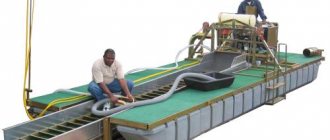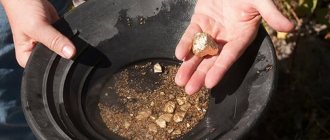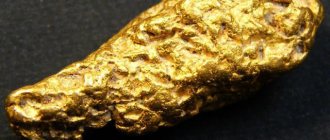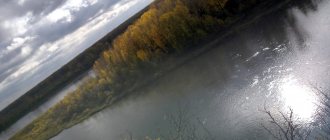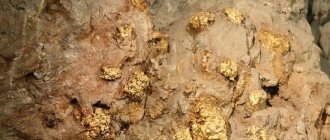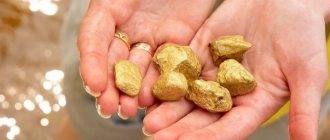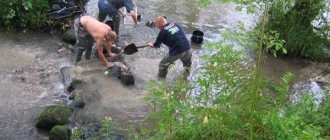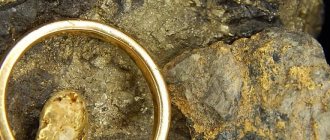Hello, dear readers! I propose to continue searching for places where a person thirsting for gold should go. These include river beds - natural deposits of the noble yellow metal.
Let's reveal the secrets of how to find gold in the river: where to look, how to mine it, how to wash it correctly, what equipment to use. And most importantly, let’s name the rivers and streams in which the richest reserves of gold grains, and even whole nuggets, lie.
Where and how does gold lie in the river?
Experts classify river gold as secondary deposits, which were formed as a result of rock destruction under the influence of natural factors (mainly temperature changes) and washing away by water flows.
Scientifically, such Au placers are called alluvial deposits, which are divided into three types:
- terraced;
- bottom;
- oblique.
To find terraced gold deposits, sometimes it is enough to get close to the river bank, which is rich in the natural form of the precious metal. They are often found in river beds, both in deep streams and at the site of dry arteries. A “terrace” is a bottom that rises above the shore level.
Bottom deposits occur in the bedrock channel, that is, in the valley where river flow passes during periods of low water. The chances of finding them are higher in areas where the bedrock is shallow. And deposits of the third type should be looked for on a river spit, be it pebbly or sandy.
Is it possible to find gold in an ordinary river?
Particles of the precious metal are scattered almost everywhere in Russia. You can look for them in any river that carries water from highlands to lowlands. Theoretically, in order to practice searching and find precious grains, there is no need to leave the Moscow or Leningrad region, much less the Caucasus or the Urals.
But in practice, the number of grains found will be negligible in monetary terms, unable to justify the expenditure of effort and time. If the task is to look for significant loot, you will have to go to the Far East or to the eastern part of Siberia - closer to the gold mines.
Life hacks for prospectors
Some tips on how to mine the yellow metal from the river to extract more:
- The largest accumulations of Au are found in natural traps - near large boulders that block and sharply slow down the flow of small mountain rivers and streams. The lower such a “golden trap” is downstream, the more metal can be found, and the purer it is.
- It is also profitable to look for gold in other places where the water flow slows down - at the mouths of mountain streams and rivulets, at turns (bends) of the riverbed.
- The precious metal accumulates near any obstacles in the path of water - in holes and whirlpools under waterfalls, on shallows and spits, near fallen trees, ledges and other irregularities.
- Bottom gold can be found not only in genuine bedrock, but also in false, representing a bottom of dense clay.
In other words, we must remember that gold is much heavier than water, streams do not carry it away, but drag it slowly along the bottom, and on the river you should look for places where it is easiest for gold nuggets and grains to freeze and settle.
Metal minerals
Balance reserves of ore minerals in the Nizhny Novgorod region were discovered in the placers of the coastal zone of the Lukoyanovsky district. Based on the results of research expeditions conducted earlier in this territory, about nine isolated placers with estimated reserves of titanium and zirconium dioxide of categories P1 and P2 were identified: Kazakovskaya, Shatkovskaya, Ulyanovskaya, Ivantsevskaya, Isupovskaya, Sungulovskaya, Itmanovskaya, Vetoshkinskaya, Neverovskaya.
The Itmanovskaya placer, located in the southeastern part of the region, is one of the most significant and richest areas. According to the obtained geological data, ore sand reserves with an approximate volume of 31 million m3 are assessed in categories B, C1 and C2. The placer extends for 6 km in length, the width in some places ranges from 0.4 to 1.7 km. The most practical layer, on average, is at a depth of 29 m. Ore sands are represented by a rather complex mineral composition (more than 20 different minerals). A significant portion of them consists of quartz, feldspars and epidote. The main ore minerals are: ilmenite, ilmenohematite, zircon, leucoxene, chromite and rutile.
Yellow metal satellites
The minerals most often found in rock adjacent to the yellow metal are silver, quartz, galena, lead, and pyrite. The first is usually found with gold in some nuggets. The latter is especially often confused by beginners with the sought-after value due to the shine and yellow color it possesses.
I regret to say that even having found these signs of presence, one cannot be sure that the location of the noble metal is also here. But even unremarkable pieces of minerals should be checked for the presence of a yellow sheen, the hue and color of which does not change when light is refracted. It indicates the presence of Au inside. If you notice such shine - congratulations, you managed to find gold!
Deposits of peat and sapropel
The first in the list of mineral resources of the Nizhny Novgorod region should be noted peat, deposits of which have been identified on an area of about 330 thousand hectares. Its deposits are divided into two territorial groups: areas of up to ten or more hectares. There are 415 registered peat deposits of the first group; they are included in the unallocated subsoil fund. There are 532 deposits with a larger area, of which only 6 are recorded in the distributed fund. According to industrial categories, their balance reserves amount to about 152 million tons of peat, undiscovered - 18 million tons. The main peat reserves are located in the Semenovsky, Krasnobakovsky and Bogorodsky districts.
Large volumes of sapropel were found in 133 lakes in the region. Its geological reserves together with resources amount to almost 23 million tons. 32 deposits, each with an area of more than 3 hectares, make up a total area of 1054 hectares.
Extraction technologies
Three main methods of extracting gold from the river, used by enthusiastic miners:
- dredge or mini-drag;
- gravitational differentiation;
- metal detector
Dredge
The dredge pumps out the rock from the bottom, moves it into a special chute and washes it, separating the gold. Its negative impact on the environment is offset by its convenience for the gold miner.
Gravitational differentiation
Gravity differentiation is the process of grinding rocks containing gold. This is an industrial method of extraction, which is suitable for developing primary deposits, but is not suitable for private individuals.
Metal detector
A metal detector is a device that probes the soil (both land and the bottom of a river) and gives a sound signal when metal is detected. The disadvantage of a conventional apparatus is that the reaction to gold and any base metal is the same.
So it is recommended to search for Au using a device in the form of a probe equipped with a sensor that reacts only to direct contact with the mineral of interest to us, helping to find gold.
Rock salt
The most valuable mineral resource of the Nizhny Novgorod region for the chemical industry is rock salt. Its deposits are located in the territories of the Koverninsky and Semenovsky districts, and a significant part is in the distributed fund of resources. Industrial salt reserves of the Belbazh deposit (Koverninsky district) are estimated at 2546 million tons. Fishing can be carried out through a salt pipeline and underground dissolution. This raw material meets all GOST requirements for food products and is used for the production of caustic soda and chlorine.
Search algorithm
Stages of hunting for precious metal deposited in the river:
- Valley exploration.
- Check the current - the stronger the current, the more gold can be found in places where it slows down.
- Drawing up a route along which to search.
- Hiking along the shore, searching for satellite rocks, and with them gold itself.
Necessary tool
The equipment of a gold miner includes a metal detector (metal detector) and a mini-dredge or a tray for washing rock.
You also need full equipment for going to the area where you are going to search and mine gold.
Common minerals
Deposits of common minerals in the Nizhny Novgorod region number about 240 objects for 10 types of extracted raw materials:
- material for mineral wool (Chuvarley deposit);
- saw stones (Ichalkovskoe deposit);
- building stones (22 deposits with total reserves of 307,289 thousand m3);
- carbonate rocks for chemical reclamation of acidic soils;
- gypsum and anhydrite (Bebyaevskoye, Selishchenskoye, Novoselkovskoye, Ichalkovskoye, Balakhonskoye and Pavlovskoye deposits);
- brick and tile material (Ryzhkovskoe and Zheltovskoe deposits);
- sand and gravel materials (Volzhskoe and Sinyavskoe deposits);
- carbonate raw materials for firing into lime (Khudoshinskoye, Ruzanovskoye and Mayevskoye deposits);
- sands for construction work and the production of silicate products (18 deposits with total reserves of 206 million tons);
- expanded clay raw materials (Uzhovsky, Prosetsky, Pesochinsky, Lukoyanovsky, Urensky and other areas).
How to wash by hand
To wash goldfish with your own hands using an ordinary tray, you need a round or rectangular trough up to 40 centimeters in size and a sieve. If, after washing, at least one grain remains in the sieve, the miner can be congratulated: the placer has been found. If not, you need to try further. Of course, such washing requires enormous patience.
The principle of operation of the mini-dredge is the suction of sand and small particles of pebbles from the bottom with mechanical separation of gold from the rock. The disadvantage of using this device is that it creates a lot of noise, attracting the attention of conservationists. To mine precious metals in this way, I strongly advise you to first purchase a license, otherwise you will face problems with the law.
The state traditionally financially supports citizens before the end of the year
2021 was a difficult period as the country faced the challenges of the pandemic. Therefore, the head of Russia suggested that the government at least somehow “sweeten the pill” for pensioners and give them 10,000 thousand rubles.
But until the official announcement of the government decision, all these conversations are theoretical. The government and the president have repeatedly extended a helping hand to low-income groups of the population and one can only hope that they will do so again. Back in September, Putin stated that older citizens need support not only verbally, but also financially.
The Russians even sent a petition to the Russian president asking him to repeat the September lump sum payment. More than 150 thousand people signed it. It remains to wait a little to understand whether Putin will hear his compatriots or not pay attention to their requests.
TOP 10 Russian rivers rich in gold reserves
Prospectors with experience have compiled a truly golden top ten watercourses, where the treasure of the same name is most abundant - that’s where it’s worth looking for:
- basin of the Siberian Lena River;
- river length Bom;
- Jalon Creek;
- Millionny stream;
- Unakha River (all in the Amur region);
- the Bodaibo River in the Irkutsk region (the city of the same name with gold mines is even mentioned in Vysotsky’s “thieves’ lyrics”);
- Bolshoy Chanchik River, a tributary of Bodaibo;
- Alekseevsky stream in the Kamchatka region;
- the Talga River in the Khabarovsk Territory;
- the Sanarka River is the only one not in Siberia or the Far East, but in the Urals, in the Chelyabinsk region.
There are quite a lot of large grains on Bodaibo and in the Millionny stream; nuggets can still be found in other streams.
Iron ores
Natural formations of iron ore are common in the southwestern part of the region. Occurring at depths of up to 50 m, siderites and brown iron ores form an ore-bearing layer with a thickness of up to 16 m.
The development of iron ores was actively carried out from the first half of the 18th century until the 30s of the 20th century. On the territory of the region, the Tashlinsko-Cherevatovsky and Vyksa districts especially stood out. The territory of the Tashlinsko-Cherevatovskaya group of iron ore deposits shares borders with the Pervomaisky, Diveevsky and part of the Voznesensky districts. The Vyksa group of deposits is located in the Oka River basin and covers the western part of the Kulebaki and the entire Vyksa districts. In the 40s, the Kozlovskoye, Motmosskoye and Doschatinskoye deposits were explored here.
Of all the minerals that exist in the Nizhny Novgorod region, the use of iron ore due to depletion is considered unprofitable.
Putin's 10 thousand rubles for children in December 2021: expert opinion
Probably no one has forgotten about “Putin’s” 10,000 rubles, which warmed both the souls and budgets of Russians all year. Let us remember that in April of this year he announced a payment of 10,000 rubles for each school-age child. The last time “ten” appeared on Russian cards was in August, just in time for school. With this money, Russian schoolchildren were both dressed and wearing shoes by September 1st. However, the New Year is coming soon and the question “Will there be more payments in December” worries millions of parents in the country. After all, it is known that due to the introduction of holidays in October-November due to the coronavirus, many were left without money. In a conversation with Courier. Wednesday,” political scientist Alexey Mazur expressed his assumption regarding Putin’s money at the end of 2021.
-On the one hand, there is now a lot of money in budget funds, due to high prices for gas and oil, and the government can pay families 10,000 rubles by the New Year. Again, the short-lockdown in the form of non-working days and the introduction of QR codes had a painful impact on many and government support would be welcome. But on the other hand, no elections or referendums are expected in the near future. Namely, in front of them the distribution of money to the population takes place. So I don’t expect such payments,” says political scientist Alexey Mazur.
Will parents of schoolchildren be paid 10 thousand rubles before the New Year?
Currently, this question is widely circulated on social networks, as people want to know in advance whether they can count on further financial support from the authorities. The latter, in turn, prefer not to force events, so they postpone comments on this topic until better times.
However, representatives of the expert community seem much more talkative. They almost unanimously claim that in December 2021, Russian President Vladimir Putin will announce new one-time payments that will affect parents of schoolchildren. In particular, we may be talking about regular one-time payments in the amount of 10,000 rubles, AiF notes.
New payments from Putin for schoolchildren: latest news today
The most popular social payment in the Russian Federation remains financial assistance to families with children. Citizens plan to receive 10 thousand rubles from the Russian Pension Fund for each child and consider this amount appropriate for the New Year. As the Ministry of Finance notes, the country's budget was replenished with revenues from the tax service - their total amount was more than 13 trillion rubles. In addition, the customs service sent five trillion rubles to the state treasury.
According to analysts, in November of this year the state treasury surplus crossed the mark of 2.1 trillion rubles. Over the next month and a half, the amount will increase slightly. Russians, meanwhile, expect that they will learn in December about the appointment of payments to families with children, because Vladimir Putin traditionally will hold a big press conference at the end of the year, Sib.fm reports.
At the beginning of summer, the President of the Russian Federation announced the payment of 10 thousand rubles to families with children to prepare for school. At the same time, the benefit was transferred for each child who receives secondary education. In the fall, they stopped paying out the money, but some enterprising parents tried to apply for a second round. Of course, nothing came of this venture, since the state did not allow itself to be deceived.
Valery Kurnosov: “The royal gold will definitely be found - and there won’t be long to wait”
WHERE ARE 17,815 KG OF “YELLOW METAL” HIDDEN IN TATARSTAN?
The sensational book “Tsar’s Gold” by the famous Kazan historian and journalist Valery Kurnosov has gone on sale in Russian bookstores. This is a historical investigation into the disappearance without a trace back in 1918 on the territory of our republic of 17.8 tons of gold. Since then, both the special services and “black diggers” have been looking for him. The author of the book confidently stated to BUSINESS Online that the gold treasure is real, as evidenced by bank documents and the results of investigations in 1918 and 1929. And in general, it’s almost clear where exactly the gold is hidden: take a shovel and just dig!
IT WAS FUNNY, AND NOT MUCH REALLY REAL
— Tell me, please, when did the royal gold disappear and why?
— This is described in great detail in my book. I think many readers will learn for the first time about the details of the successful uprising of the Savinkovites in Kazan on August 6, 1918 and the effective actions of Vladimir Kappel’s troops to seize the state’s gold reserves, about the connection between the murder of the German ambassador Count Mirbach and the gold stored in the Kazan branch of the state bank.
For me, this topic is such luck... Remember the phrase from the film “Seventeen Moments of Spring”: every intelligence officer knows that great luck comes once in a lifetime. A journalist also has such luck once in a lifetime.
Although, when I came across such a topic, I did not immediately understand that this was a genuine sensation and that I needed to use it to the fullest. My attitude towards royal gold changed and developed depending on how much I delved into the topic. At first I thought she was funny, exotic... with a touch of schizophrenia. Well, as if someone began to claim that they met little green men... And here it’s about the same: well, what kind of royal gold is there in the twenty-first century? It was funny. This doesn't seem very true...
- Yes, you perceive it more like a legend.
— So at first I treated this topic with skepticism. But I learned that there was a person in Kazan who proposed a story about the Tsar’s gold to Channel One journalists, and they made it there. I looked at it in Moscow and became interested. Moreover, as a historian, I heard something about this before. But again, as a historian, when I watched the TV report, I felt that something was wrong. It is hard to explain. Here is a musician who has an ear for music but hears false notes...
I had just moved to work from Gazeta to Argumenty Nedeli, and there I immediately proposed this topic. The editor also thought it was funny at first, but said let’s do it. And I took it seriously.
THE BOOK HAS A MAP OF THE AREA WHERE THEIR ROYAL GOLD WAS LOOKED FOR
— Your education as a historian probably helped you?
- Naturally. While working on the topic, I became more and more convinced that everything there was much more complicated than it had so far been presented in the press. I went to the national archive of the Republic of Tatarstan. It turned out that they remembered me there from publications in the newspapers “Evening Kazan” and “Kazanskie Vedomosti”, and they readily helped me find the documents. There were also some that were not mentioned in the press.
— You have a lot of documents in your book...
- Of course, this is research. Therefore, I quote State Bank documents, publish their photographs, and provide links to declassified archival documents. In the book I used information from the National Archives of Tatarstan, from the so-called Red Book of the Cheka; as well as over two dozen works by historians; newspaper and magazine publications from the beginning of the last century and modern ones, protocols of the secret Soviet-French treasure-hunting expedition of 1929 under the leadership of representatives of the State Bank of the USSR. Moreover, the book even published a map of the area where the royal gold was sought.
- With a cross in place of the treasure?!
— Probably, each seeker puts his own cross.
THERE'S GOLD THERE, THERE'S MILLIONS!
— So I followed a very interesting path in studying the “golden theme”: at first there was distrust, then the most interesting discoveries, and then an understanding of the situation came: this is gold, there are millions there! And if you find them...
“Then, perhaps, according to the law, the finder is entitled to something?”
- I thought so too: it would be great if I found and became a millionaire... As they said in one of the films: “I dug with a shovel, and I’m rich”! Moreover, I managed to find a lot of materials on the topic. Indeed, one gets the feeling: well, it’s clear, take a shovel and just dig... There are, for example, very detailed search protocols of the State Bank expedition - a very serious organization.
It's clear that I got carried away. And he suggested to the editor that he organize a search for the royal gold. If we find it, we will become millionaires. If we don’t find it, we’ll make a series of cool materials and photographs, the newspaper’s circulation will probably increase.
But I understood that various questions might arise for self-proclaimed treasure hunters, so I thought that, probably, the editor needed to discuss everything with lawyers and someone from high authorities.
The editor went upstairs to confer. And when he returned, he suddenly said: we are not writing anything more on this topic. This really touched me: how can this be such interesting material?! And I said that I would never give up this topic. In the end I had to quit...
THERE IS A “TREASURE” AND THERE IS A “FIND” - THESE ARE TWO BIG DIFFERENCES
— But you continued to work on the topic?
- Continued. And, one might say, completely disinterestedly. Because I studied the laws and found that even if I found gold, I would not receive any reward. In general, in principle! There are various legal nuances, but in general the meaning of the law is as follows - I wrote about this in the appendix to my book: in the Civil Code of Russia there is an article “treasure” and there is an article “find”. A treasure is when the owner is unknown, and a find is when the owner is known. In this case, the owner of the royal gold is the state. If someone finds gold, the owner may be reimbursed for the search costs, and only if he deems it necessary. And the find will have to be returned without any reward. The one who found it will not receive anything from it. That is, to steal royal gold - yes, it is possible, but, alas, it is impossible to officially receive a reward for it according to the law.
- What a pity! Have you given up?
“I realized that there was only one thing left for me: to write a good book and tell everyone about the royal gold.” True, I was afraid that if I wrote, there would be a stir and many would rush to look for gold. Remember in Jack London what passions boil over gold, how gold miners kill each other...
“Aren’t you tempted to at least look at the place where such a treasure is buried?”
- No, I have never gone to the place where the gold is hidden, although I have a very good idea where it is. Using photographs from space, you can accurately find the place where they dug, where they looked for this gold. Exactly that very clearing, and no other. But I didn't go there. Although I know who is looking there...
YOU CAN'T CARRY 18 TONS IN YOUR POCKET
- How many chances do you have to find it? Give your assessment - historian...
- Gold will definitely be found. It is unknown when this will happen, but I think that the wait will not be long. Because now the level of technology is completely different. I’m telling you that I established the location of the clearing where they were looking for gold without leaving the apartment. I just looked at satellite photos and compared them with search protocols.
This is my opinion, and all the documents that I have seen say that the gold is hidden in the forest. But this forest is 193 square kilometers, very large. And they were looking for gold there in one area, which was indicated by the owner of the information. They searched there, but found nothing. But then it turns out when you start to analyze that this source, this man, later, in 1939, that is, 10 years later, suggested looking for gold again. But if in 1929 all participants in the expedition, and there were a lot of people there, were given 20 percent if the treasure was found, then 10 years later the source of information said: give me 45 percent, no less, and then I will show you where it all lies . But it was already 1939, on the eve of World War II, and in Russia there was no time to search for treasure... And then there was a war, and the man who knew the place where the gold was hidden did not survive the war.
Once again, in 1963, employees of the OBKhSS of our republic were looking for royal gold. Now “black diggers” are slowly looking for gold.
- Is it still there?
- Undoubtedly. You can’t carry almost 18 tons in your pocket and you can’t sell it on the market unnoticed. The gold is still in that forest...
Elena Chernobrovkina
Reference
Valery Kurnosov
Born on May 20, 1961 in Kazan.
In 1984 he graduated with honors from the history department of Kazan University.
In 1984-1989 he worked as a history teacher, in 1990-1995 - a deputy of the Kazan City Council.
Since 1991, he began working as a journalist - he worked for the newspapers “Evening Kazan” and “Kazanskie Vedomosti”. During the days of the State Emergency Committee, he collaborated with Ekho Moskvy, worked on radio Passage, in a number of online publications, in the newspapers Russian Germany (Berlin) and Continent USA (Chicago).
Since 2005, he has worked in the Moscow media - on the Orthodox satellite TV channel, as a correspondent for the newspaper “Our Time”, the incident department of the newspaper “Gazeta” and as a special correspondent for the investigation department of “Arguments of the Week”.
Kurnosov maintains his own blog, https://kurnosov.livejournal.com/, which contains details about the book “Tsar’s Gold”.
